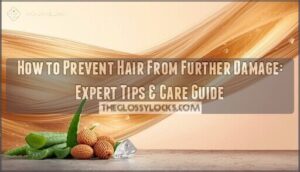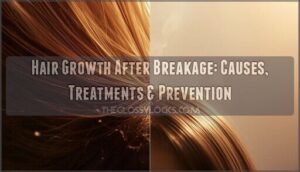This site is supported by our readers. We may earn a commission, at no cost to you, if you purchase through links.

Shedding is a normal part of having texture-rich hair; however, excessive breakage may be caused by improper care or product buildup on your strands.
Table Of Contents
- Key Takeaways
- Understanding Hair Shedding and Breakage
- Identifying the Root Cause of Shedding
- Tips to Minimize Breakage and Shedding
- Preventing Breakage and Enhancing Hair Moisture
- Promoting Healthy Hair Through Nutrition and Care
- Evaluating the Need for Professional Help
- Recommended Products for Reducing Shedding and Breakage
- Expertise and Credibility of the Author
- Conclusion
Key Takeaways
- Shedding is a natural part of the hair growth cycle, even for 4C hair.
- Excessive shedding in 4C hair can be caused by genetics, stress, and diet.
- Proper nutrition and hydration are crucial for maintaining healthy 4C hair.
- Deep conditioning, protein treatments, and protective styling can help reduce shedding and promote hair health in 4C hair.
Understanding Hair Shedding and Breakage
It’s important to differentiate between hair shedding and breakage when it comes to 4C locks. Shedding is a natural part of the hair growth cycle, while excessive shedding can be caused by stress, diet, or genetics.
Signs of breakage include misaligned strands, dryness, and tangles. A balanced diet with proper hydration, as well as heat styling precautions, is essential for preventing further damage.
Differentiating Between Shedding and Breakage
Knowing the difference between shedding and breakage is key to maintaining healthy 4C hair. In fact, 8 out of 10 people who experienced excessive shedding found that it was due to a lack of moisture.
Shedding occurs naturally when hairs reach the end of their life cycle and can be identified by white bulbs at the root. On the other hand, breakage results from over-manipulation or harsh styling techniques like heat or coloring.
To prevent breakage, reduce manipulation with protective styles and maintain hydration levels with water-based products. Regular trimming also helps eliminate split ends before they become more serious issues.
Incorporating proteins into your diet, as well as regularly washing your pillowcase, can help keep strands strong too.
Causes of Excessive Shedding
It’s essential to distinguish between the causes of excessive shedding, such as genetics, over-manipulation, and lack of moisture. Hair care routines play a role in preventing breakage and promoting growth. Diet influences can also contribute to hair loss; adequate nutrition is key for healthy 4C hair.
Genetics may be a factor in some cases, while stress has an impact on both shedding and breakage due to weakened follicles or alopecia areata.
Signs of Hair Breakage
Signs of hair breakage include misaligned strands, dryness, and tangles – all important indicators that it’s time to take action! Prevention is key: use heat protectant sprays when styling and opt for t-shirt or microfiber towels instead of regular towels.
Implement the LOC/LCO method for moisture retention and protective styles to reduce manipulation. Mindful product choices are essential; avoid harsh chemicals and shampoo no more than twice a month.
If you’re still struggling with breakage, seek professional help from nutritionists or dermatologists who can evaluate your diet, stress levels, and hair care routine.
Identifying the Root Cause of Shedding
It’s not unusual for 4C hair to experience excessive shedding due to genetics and hormonal imbalances, as well as inadequate nutrition and hair care practices. To identify the root cause of your own shedding issues, assess these contributing factors while considering changes in diet, stress levels, and personal grooming habits.
Genetics and Hormonal Imbalances
Uncovering the reasons behind excessive shedding could be as simple as exploring your genetics and hormonal imbalances. Hormones can affect hair growth, causing more shedding than normal. Additionally, a genetic predisposition may make some individuals less resistant to breakage or cause an imbalance in their natural oils that leads to increased dryness and fragility of the strands.
Identifying these underlying issues is key to maintaining healthy 4C hair and reducing excessive shedding due to hormone-related causes or a family history of hair loss/thinning over generations. Proper care for 4C hair includes understanding how genetics impact its strength.
Inadequate Nutrition and Hair Care Practices
To keep your 4C hair healthy, it’s important to ensure that your diet and hair care practices are adequate. Eating a balanced diet with plenty of water, protein, iron, and biotin can help maintain moisture balance in the scalp.
Protein treatments can strengthen the strands, while regular deep conditioning helps prevent breakage from occurring due to dryness. When styling, opt for protective styles that don’t require too much manipulation or tension, such as braids or twists.
Stay hydrated between wash days by using light oils and moisturizing regularly with water-based products for the best results when avoiding excessive shedding in 4C hair.
Tips to Minimize Breakage and Shedding
It is essential to keep 4C hair moisturized and hydrated in order to prevent breakage and shedding. Proper detangling, deep conditioning, water-based products, and protective styles – these are just a few of the steps you can take to ensure your hair stays healthy.
Moisturizing and Hydrating Your Hair
Proper hydration and moisturizing are key to minimizing breakage in your 4C hair. Hydrate the scalp with water-based products like leave-in conditioners, curl creams, and oils. Invest in a quality microfiber towel or satin bonnet for nighttime protection from friction.
Implement the LOC/LCO method to retain moisture. Layer light oil over cream or liquid to lock it all in place.
Incorporate these techniques into your routine to maintain healthy 4C hair that won’t suffer from excessive shedding and breakage!
Avoiding Heat Styling and Harsh Chemicals
It’s important to minimize heat styling and harsh chemicals in your hair care routine, like avoiding the scorching summer sun. Heat-free styling is essential for preventing breakage and promoting healthy 4c hair growth.
Chemical-free products are beneficial for avoiding damage and protecting the scalp from irritants.
Protective styles limit manipulation, tension, or friction on delicate strands while preserving moisture retention. Regular deep conditioning with water-based products can help strengthen fragile follicles, reduce shedding, and prevent split ends over time.
Following these tips consistently can promote hair health.
Implementing Protective Styles
Protective styles are an effective way to reduce manipulation and tension on 4C hair, helping to minimize breakage. These styles include braids, two-strand twists, bantu knots, and updos. They can be combined with moisturizing products like oil or leave-in conditioner for extra hydration.
The LOC/LCO method is also important. Use a liquid like water as the first layer of moisture, followed by a cream or butter to lock it in place. Regular trimming every 4-6 months will help prevent split ends that lead to breakage.
With consistent application of these methods, you’ll soon have healthy-looking natural hair!
Preventing Breakage and Enhancing Hair Moisture
To keep your 4C hair healthy and prevent breakage, it’s essential to take the proper steps when drying and restoring moisture. Investing in a microfiber towel for faster drying time is one step; implementing the LOC/LCO method will help retain moisture throughout the day.
By taking these precautions, you can ensure that your hair stays strong and hydrated for long-term health.
Proper Hair Drying Techniques
To reduce breakage and enhance moisture, it’s important to select the right drying method for 4C hair. A microfiber towel is great for its absorbency, reducing frizz, and cutting down on drying time. Leave-in conditioner can help repair split ends, while coconut oil makes an excellent all-purpose product with a high smoke point of 350°F.
Using the LOC/LCO Method for Moisture Retention
You can optimize your 4C hair’s moisture and reduce breakage by implementing the LOC/LCO method. This technique involves layering water-based products to achieve optimal hydration while avoiding product buildup.
Benefits of this method include improved curl definition, less frizz, increased softness, and decreased split ends. The best products for this method are leave-in conditioners or creams that contain natural oils like coconut oil or shea butter for extra nourishment.
In addition, protective styling helps retain moisture and reduce hair manipulation, which often leads to breakage.
Promoting Healthy Hair Through Nutrition and Care
To ensure healthy 4C hair, it’s important to focus on consuming a balanced diet with water, protein, and iron; protecting your hair at night with satin or silk pillowcases or bonnets; deep conditioning at least once a week; and using protein treatments to strengthen the strands.
These steps will help you maintain beautiful 4C hair that is soft, hydrated, and less prone to breakage.
Consuming a Balanced Diet
Maintaining a balanced diet of water, protein, and iron is essential for healthy 4C hair. Consuming at least 2 servings of biotin-rich foods per day can make a significant difference. Healthy eating habits that include plenty of nutrient-dense foods like fresh fruits and vegetables also provide vitamin D, omega-3 fatty acids, zinc, and other vital nutrients for hair growth.
Hair supplements may be beneficial in some cases as well to promote strong strands with less shedding.
Protecting Hair at Night
Sleeping with a satin or silk pillowcase or bonnet can help protect your 4C hair from breakage and damage. Satin pillowcases reduce friction, allowing moisture retention while you sleep. Silk bonnets prevent rubbing of the fabric on the scalp, which can cause breakage as well.
Leave-in conditioners provide an extra layer of protection against dryness and split ends throughout the night.
Deep Conditioning and Protein Treatments
To keep your locks looking and feeling their best, be sure to regularly deep condition and add protein treatments. Protein benefits include strengthening weak 4C hair while helping maintain a moisture balance.
Treatment options range from traditional store-bought products to homemade solutions like coconut oil or an egg mask for breakage prevention.
Regularly incorporating these steps into your routine can increase the resilience of 4C hair against damage caused by heat styling, color processing, or tight hairstyles.
With consistent care following these tips, you’ll soon be on track towards healthier 4C strands that are strong enough to handle any style you desire!
Evaluating the Need for Professional Help
If your 4C hair is shedding excessively or you are struggling to care for it properly, seeking professional help may be the best solution. It’s important to actively manage your hair health by consulting with a nutritionist and/or dermatologist who can guide you in creating customized solutions based on diet, lifestyle changes, and other treatments.
When to Seek a Nutritionist or Dermatologist
If you find yourself struggling to tackle excessive shedding in your 4C hair, it may be beneficial to seek help from a nutritionist or dermatologist for an expert opinion. A nutritionist can evaluate dietary factors that contribute to hair health, such as biotin, zinc, and omega-3s, while a dermatologist can diagnose any underlying issues with the scalp or hair shaft.
Professional advice is essential if you want solutions tailored specifically for your situation. With their guidance, you’ll be able to identify relevant causes of breakage and create an effective regimen suited towards strengthening weak 4C strands.
Importance of Active Hair Care Management
Taking proactive steps to actively manage your hair health is essential for maintaining healthy 4C hair. A nutrient-balanced diet, protective styles, and gentle detangling techniques are all key components of a good regimen.
Professional guidance may be necessary if one’s own efforts fail to produce desired results or if excessive shedding is experienced beyond normal levels. Moisture retention, achieved through the LOC/LCO method, can help reduce breakage.
To keep hair healthy, it is important to avoid harsh chemicals such as dyes and relaxers. However, experimenting with color can be done safely under professional supervision, providing additional styling options that enhance confidence without compromising the overall condition of your locks.
Recommended Products for Reducing Shedding and Breakage
If you’re looking for ways to reduce shedding and breakage in your 4C hair, the Hicober Microfiber Hair Towel, Cantu Shea Butter Leave-in Conditioner, and Organic Coconut Oil Extra Virgin are excellent products to consider.
These three items will help keep your curls hydrated while protecting them from excessive manipulation or heat damage.
Hicober Microfiber Hair Towel
Feel the power of Hicober’s Microfiber Hair Towel, which soaks up moisture like a sponge to dramatically reduce drying time and promote healthier hair. It is gentle on 4C curls, reducing frizz and breakage while being colorfast and fast-drying.
The lightweight design won’t come loose during use, with a snug fit on the head for maximum absorbency.
Cantu Shea Butter Leave-in Conditioner
Try Cantu Shea Butter Leave-in Conditioner for a nourishing treatment that helps repair split ends and reduce breakage. Its natural formula is free of sulfates, parabens, and silicones, making it suitable for all hair types.
Not only will this product help strengthen your 4C hair, but it will also provide incredible moisture retention.
To ensure optimal results from using Cantu products, make sure to use protective styles regularly and limit heat styling as much as possible.
Investing in a satin or silk pillowcase or bonnet when sleeping is also recommended.
Organic Coconut Oil Extra Virgin
Experience the amazing benefits of Viva Naturals Organic Extra Virgin Coconut Oil for your hair and skin! This oil is unrefined, made from fresh organic coconuts, and has a light flavor. Use it to moisturize hair for better detangling or try its nourishing properties as an overnight mask.
Strengthen strands with regular use while protecting against breakage caused by environmental aggressors like heat styling tools.
Enjoy the convenience of a 16 Fluid Ounce container that’s Keto-friendly and Paleo-approved — perfect for cooking too! With so many advantages in one product, you can trust this versatile coconut oil when it comes to your hair nutrition needs.
Expertise and Credibility of the Author
Leah Marie Priest, the author of Why is My 4C Hair Shedding So Much?, holds a degree in Cosmetology, and her work has been reviewed by a team of medical professionals for accuracy. With her expertise and attention to detail, you can trust that the advice given in this article will help you regain control over your hair shedding issues.
Author’s Degree in Cosmetology
Trust the author’s cosmetology degree for their expertise in hair care advice. Leah Marie Priest, the author of this article, holds a degree from an accredited university, allowing her to provide readers with valuable insight into styling techniques and hair health tips.
She has been professionally tested for accuracy when it comes to providing reliable information about 4C hair and its issues, such as excessive shedding. With her qualifications, she is able to offer trustworthy advice on topics like curl activators, heat protectant sprays, deep conditioning methods, and protective styles.
These tips can help reduce breakage while maintaining healthy moisture levels in natural locks.
Leah’s articles are not only informative but also inspiring, thanks to personal experiences shared by other readers within the comments section.
Review by Medical Professionals
You can have confidence in the article’s accuracy, as it’s reviewed by a team of medical professionals.
Their insights provide accurate information on why 4c hair shedding occurs and how to prevent it. Common causes include genetics, hormone imbalances, and improper care practices. Treatments involve reducing heat styling and moisture retention through protective styles.
Mythbusting tips also help dispel myths about excessive shedding being due solely to lack of hydration or malnutrition.
All this ensures you get the safest advice for healthier hair without breakage or split ends.
Conclusion
Excessive shedding of 4c hair can be a frustrating experience. Did you know that, on average, a person sheds between 50-100 hairs per day? It’s important to differentiate between shedding and breakage to identify the underlying cause.
Shedding is a natural part of the hair growth cycle, while breakage is caused by overstyling, heat, and inadequate hydration. To prevent and reduce breakage, focus on keeping your 4c hair moisturized and protected.
Additionally, evaluate your diet, stress levels, and hair care routine. By understanding why your 4c hair is shedding so much and taking steps to improve hair health, you can minimize breakage and enjoy healthier, more resilient hair.











